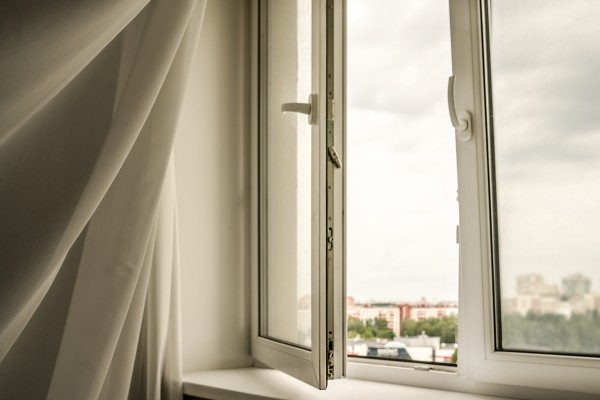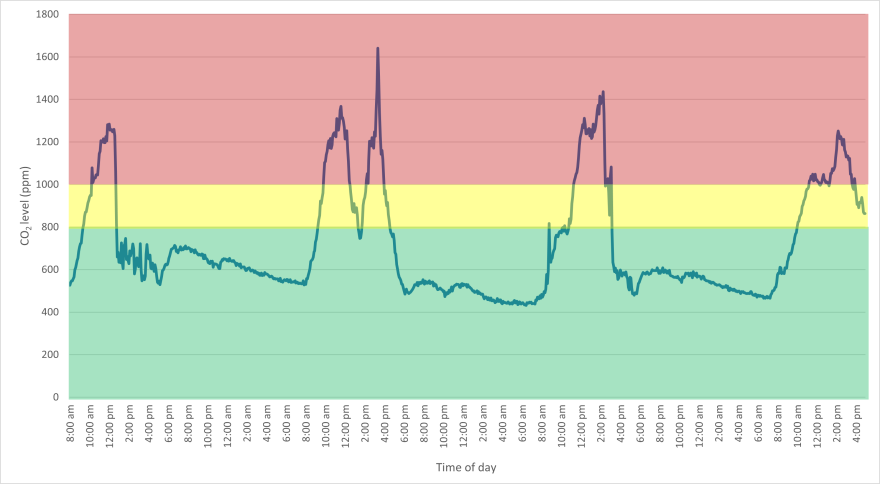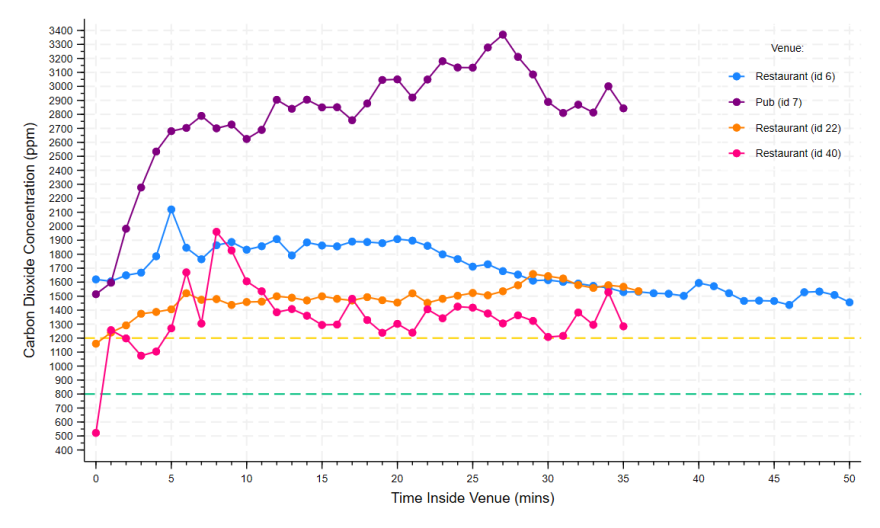Summary
Nothing is more fundamental than the air we breathe. Taking place every year on the 8 November is World Ventil8 Day. This day aims to raise awareness of the importance of ventilation as a crucial part of enabling health and wellbeing. Breathing clean air is so often ignored or poorly understood – and we usually only notice when there is a problem. Good ventilation not only reduces our exposure to air pollutants and infectious diseases, it also enables us to think more clearly, sleep better and be more productive. Aotearoa NZ lags behind comparable countries on indoor ventilation standards.
Introduction
Ventilation is the process of introducing fresh air into indoor spaces while removing stale air. As people spend around 90% of their day indoors, the air we breathe has a direct impact on our health and wellbeing. As well as having indoor sources of pollution, pollutants can enter buildings from outside sources.
Replacing stale indoor air can remove respiratory pathogens, which can help prevent the spread of respiratory infections. Ventilation is also critical to enable the removal of pollutants and excess moisture from buildings, which can accumulate from activities such as cooking, cleaning, showering, and heating.1 Inhaling these pollutants over time can cause respiratory and cardiovascular illness, allergic symptoms, cancers, and premature death.2 The World Health Organization (WHO) states that poor indoor air quality, due to a lack of effective building ventilation is directly linked to 3.8 million deaths worldwide every year. In Aotearoa New Zealand (NZ), it is estimated that air pollution is responsible for 3,317 premature deaths each year and is linked to an estimated 13,155 hospitalisations.3
Ventilation in NZ
In NZ, most homes rely on natural ventilation, with the addition of localised air extraction systems such as range hoods and bathroom extractor fans to remove moisture and pollutants. The NZ Building Code lags behind other comparable countries, with new buildings, still having the potential to be cold, mouldy, and unhealthy.4 While the Building Act 2004 acknowledges health, health is not placed at front and centre of the Code.
The NZ Building Code has minimum requirements for ventilation, with Clause G4 requiring adequate ventilation to all occupied spaces consistent with their maximum occupancy and intended use. That generally equates to all the air in your house being changed every three hours, the air in the kitchen should be changed every hour, and air in bathrooms should be changed every two hours. While all building work must comply with the Building Code, this Code only applies to new builds, or buildings undergoing upgrades. For decades, a range of experts have called for these standards to be improved.4
Although a recent review was conducted during the Covid-19 pandemic, there appears to be minimal change to ventilation requirements. In addition, systematic science-based approaches to improve indoor air quality in NZ buildings are missing. This gap is in stark contrast to outdoor air quality guidelines, standards, and national monitoring that occurs throughout NZ and internationally.
Examples of indoor air quality in NZ buildings
One way to measure ventilation is through the use of a carbon dioxide (CO2) monitor. CO2 is present in every breath we exhale, so when we breathe indoors the CO2 level will rise. However, with effective ventilation, the CO2 levels will remain low. High CO2 levels are directly correlated to low productivity and can lead to headaches, poor concentration, nausea, and sleepiness.5 In addition, if someone in the room has a respiratory infection, a high CO2 level indicates that you are more likely to be breathing in the air that the infected person has exhaled. Viruses can linger in stale air, raising the risk of infection. A high CO2 level can also indicate that levels of other pollutants may be increasing.
New Zealand standards recommend ventilation be sufficient to keep CO2 levels below 1,000 parts per million (ppm). However, the US Centres for Disease Control recommends a lower threshold of 800 ppm. In other countries, such as Belgium, legislation requires CO2 levels to be displayed on monitors in public spaces (see more details in Appendix).
There is little monitoring done in NZ buildings. However, data our group has recently collected indicates that NZ homes may be reaching well beyond the CDC-recommended maximum level of CO2, particularly overnight in bedrooms (Figure 1). Newer homes may be even more at risk, as homes are becoming increasingly airtight. Other buildings are also reaching well beyond recommended levels. Our recent CO2 monitoring in shared spaces like medical centre waiting rooms (Figure 2) and hospitality venues such as pubs and restaurants (Figure 3) also indicate levels well above 800 ppm.
Figure 1: Example of CO2 levels in a NZ home, over 10 days, reaching levels far in excess of recommended NZ Standard levels of 1000 ppm (green area of the graph)
Figure 2: Medical Centre waiting room CO2 levels over a 4-day period, in excess of the CDC recommended level of below 800 ppm(green)
Figure 3. Example of CO2 levels in NZ hospitality venues, reaching levels far in excess of recommended CDC recommended 800 ppm (green line)
What can we do?
In NZ we largely rely on occupants to ventilate buildings – that means how fresh the air is comes down to how often and how well people ventilate, usually by opening doors or windows, or using extractor fans. The main way people can improve their indoor air quality is to remember to ventilate! Even opening windows or doors for 10 minutes a day, every day, is a start to improving indoor air quality. However, it is increasingly recognised in many other jurisdictions throughout the world that relying on occupants to open windows to remove moisture and pollutants is not a successful ventilation or indoor air quality strategy.
In the future we should be building homes that rely less on occupants to do this mahi, and instead install mechanical ventilation systems which can self-ventilate when CO2 levels or other pollutants are elevated. Smart technology may also help, sensors are already available that could be used in existing homes and buildings to measure CO2 levels and other pollutants, to help us to understand when our buildings need more fresh air. Following the lead of countries like Belgium and requiring public spaces in NZ to have visible CO2 monitors and good ventilation would also go a long way to improving indoor air quality in these spaces.
Conclusions
Nothing is more fundamental than the air we breathe. Understanding and controlling building ventilation can improve the quality of the air we breathe. Breathing clean air can prevent the spread of respiratory infections and reduce other health risks, such as cancers, heart attacks, and asthma. It can also increase productivity, learning outcomes and sleep quality. To improve indoor air quality, other international Building Codes have started to incorporate requirements for mechanical ventilation in homes. NZ should put health front and centre of the Building Code and adopt indoor air quality guidelines, to ensure we are all breathing air that enhances our health and wellbeing.
What is new in this briefing?
- There is little NZ data available to indicate how well-ventilated our buildings are. However, what data is available indicates that a wide variety of buildings (e.g. medical centres, homes, bars, restaurants) in NZ do not meet the current NZ Standards. These Standards and our Building Code lag behind other comparable countries.
Policy implications
- Indoor air quality needs to be seen as a public health issue so that policymakers are enabled to develop more sustainable pathways to improving air quality.
- Health benefits will be seen if the importance of breathing unpolluted indoor air is incorporated into building design and operation.
- NZ needs to set and implement indoor air quality standards.
- NZ needs to update the Building Code.
- NZ should implement CO2 monitors in public spaces to ensure these spaces are adequately ventilated.
Authors details
Dr Julie Bennett – Senior Research Fellow, Department of Public Health, University of Otago, Wellington
Dr Caroline Halley – Senior Research Fellow, Department of Medicine, University of Otago, Wellington
Kate Macnab – Masters of Public Health, University of Otago, Wellington
Acknowledgements
The authors thank Airsuite for the use of their Airsuite Glance monitors.
Appendix
Ventilation types
Understanding the sources of pollution and the occupancy of the building will help to determine what ventilation may be needed. There are three types of ventilation. Natural ventilation is when air is exchanged in a building through openings (windows/doors/vents) in the building envelope. While mechanical ventilation is when a fan is used to blow fresh air or extract stale air from a building through a duct. Hybrid ventilation uses both; natural ventilation when this is sufficient to clear the air, but switching to mechanical extraction ventilation when it is not.
Air quality regulations and recomendations
The NZ Standard 4303:1990 Ventilation for acceptable indoor air quality, which was last reviewed in 1990, recommends ventilation be sufficient to keep CO2 levels below 1,000 parts per million (ppm). However, internationally the Centres for Disease Control and Prevention (CDC) recommends keep CO2 levels be kept below 800 ppm. Belgium recently introduced legislation that requires all public spaces to have a CO2 meter clearly visible to the public and managers of public spaces are required to carry out a risk analysis of all factors that influence indoor air quality. In addition managers are required to draw up an action plan if issues with ventilation are identified.
Early this year the CDC released a new health-based ventilation target that could dramatically improve indoor air. This new goal is ambitious requiring buildings to have at least five air changes per hour (ACH), meaning the equivalent of all the air in a room is replaced five or more times within an hour. For context, a typical home has less than 0.5 ACH and in NZ we are building new homes with even less (as mentioned above the Building Code requires one air change every three hours). This represents the first time in history that the agency has set a ventilation target to address respiratory infectious diseases.
The CDC also made other important recommendations, such as raising minimum filtration rates (for mechanical ventilation systems) with higher-grade filters (MERV-13), which capture not only particles from lungs but also those from outdoor and indoor air pollution. Implementing these recommendations in NZ would ensure our new buildings have good ventilation, which is essential to maintaining a healthy indoor environment and protecting building occupants from adverse health and productivity outcomes.




